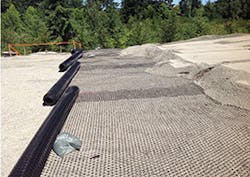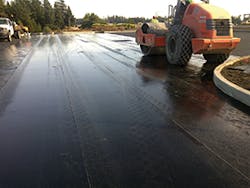Spikes in population call for innovative approaches to transportation and infrastructure challenges.
This was the case in Thurston County, WA, where residents were facing a dramatic increase in traffic due to the closure of a nearby park-and-ride facility that was operating beyond capacity. In conjunction with a noticeable increase in population to the area, the community was stretched for space and in need of expanded park-and-ride resources.
In order to meet the growing demand, a sustainable transit solution that could be integrated with limited existing available land was needed. The most ideal solution would minimize the disturbance of existing roadway infrastructure and would take into account the natural aesthetics of the surrounding area.
The situation prompted Intercity Transit, Thurston County’s public transportation provider, to commission a feasibility study in 2008 to find a solution for addressing parking and traffic needs. During the study, Seattle-based KPFF Consulting Engineers worked to assess the structural integrity and potential cost of building a park-and-ride facility atop a portion of the retired Thurston County Waste and Recovery Center landfill site.
The results of the study determined that the proposed design concept was viable, so the transit agency applied and eventually received project funding from the Washington State Department of Transportation (WSDOT) Regional Mobility Grant program. While project funding and receiving an official notice to proceed were significant challenges, project implementation was also highly complex, requiring unprecedented planning and coordination.
“There were many pieces to this project, and a high level of cooperation was key to its success,” said Marilyn Hemmann, Intercity Transit procurement and capital projects manager.
Defying Unstable Ground
Due to the nature of the site, the project was developed in a series of phases to address multiple challenges.
The feasibility study confirmed that differential settlement would continue over time as existing onsite waste materials continued to decompose. With this in mind, site stabilization clearly became a critical component of the build-out.
An aged and outdated methane gas collection system, used to collect the gas generated by decaying waste, also needed to be replaced. This was initially addressed in the first phase of the project when engineers set out to prepare the site for construction. Temporary modifications were made to the collection system and to the existing landfill cover before preloading the site with 148,000 tons of surcharge fill required to stabilize the subsoil and refuse.
Project engineers also faced challenges resulting from varying landfill surface heights ranging from 25 feet to 40 feet. The type and extent of ground improvement required depended on the amount of site grading needed to prepare the site for construction. To address this issue, different methods of ground improvement were studied.
“We looked at the pros and cons of dynamic compaction versus surcharge, and we recommended surcharge,” said KPFF’s Bob Holcomb, P.E., project engineer and project manager. Some of the benefits associated with surcharging a site include but are not limited to minimizing the impact on adjacent properties, limiting the need for special equipment, and minimizing overall construction cost.
Crews from Tucci & Sons began on the preload phase of the project and raised the gas collection system above the preload level so that compaction could begin.
“We completed the preload in two phases,” Holcomb continued. “One half of the clean fill material was placed and allowed to settle for six months. The remaining half was then placed and allowed to settle for the same amount of time.”
Once compaction was complete, the layered construction of the facility began. The engineers and contractor’s first task, however, was to design and install the permanent methane gas collection system.
“We replaced the temporary gas collection system with a leachate system,” explained Chris Hansen, project manager for Scarsella Brothers, the general contractor for the construction phase. The company also addressed storm water runoff issues at that time.
Tensar’s GlasGrid asphalt reinforcement system has a tack coat already applied.
Construction Begins
Once the consolidation phase was complete, the contractors installed Tensar TriAx TX140 Geogrid to reinforce the subgrade that was placed over the capped landfill.
Some of the workers, including John Jaggi, Scarsella project superintendent, had never worked with Tensar products before, but knew the product was the right choice for the project.
“From beginning to end, installation was a smooth ride, without any wave action,” said Jaggi. “It’s easier to pin and secure than a solid (geotextile) material. I was thoroughly impressed-it was rock-solid how the layers linked together, like walking on a gravel pit floor.”
Holcomb had a similar observation, noting that the surface was solid and the vibrations ended once the Geogrid went down. Holcomb further explained that in areas supporting commuter lanes and parking, a single layer of Triax Geogrid was installed. A 12-inch layer of fill was placed next, followed by a geomembrane liner, an additional 30 inches of fill and paving. The paving featured four inches of crushed surfacing topped with 3 inches of asphalt.
The areas supporting bus traffic were constructed differently. A 12-inch fill was placed over the existing liner, followed by the geomembrane, then, within the final 60 inches of fill, two layers of TriAx TX140 Geogrid, spaced 16 inches apart, were installed. Paving included a 3-inch layer of asphalt, reinforced with GlasGrid 8501TF (tack film) pavement reinforcement system, topped with an additional 3 inches of surface asphalt. Tensar’s GlasGrid system provides asphalt reinforcement and has a tack coat already applied, allowing contractors to complete two steps in one.
While concrete is typically used in bus lanes and turnarounds, asphalt was specified for the entire project due to its flexibility in the event of differential settlement, which is a significant concern considering the previous use of the land.
For this project, both the TriAx Geogrid and the GlasGrid System were sourced through the ACF West office in Fife, WA, which is Tensar’s distributor in that region. A Scarsella Brothers crew of five workmen installed the GlasGrid System with its pre-applied tack film.
“I was skeptical, but it tacked right down. It was easy to work with, and we didn’t have one spot that didn’t tack,” Jaggi commented. “On the second roll, it was as if the crew had been working with it forever. The crew completed the installation in about five hours. “
Award-Winning Results
The project was completed on budget at $8.2 million. In January 2013, after five years of planning and development, Intercity Transit officially opened the Hawks Prairie Park & Ride lot in Lacey, WA, just minutes from Washington’s capital, Olympia.
The innovative, 8-acre facility became the third major park-and-ride facility in the area, doubling the region’s park-and-ride capacity to a total of 759 stalls. The opening of this lot increased the South Puget Sound region’s park-and-ride capacity by more than 75%. It also helped relieve a heavily congested segment of Interstate 5, and was an effective and sustainable solution for this piece of public land.
Enthusiasm for this project has extended well beyond the opening ceremony. In May 2013, the American Public Works Association chose the Hawks Prairie Park & Ride facility as Washington State’s Project of the Year in the $5 million to $25 million transportation category. Criteria included construction management, safety performance, community relations, and environmental vigilance.




